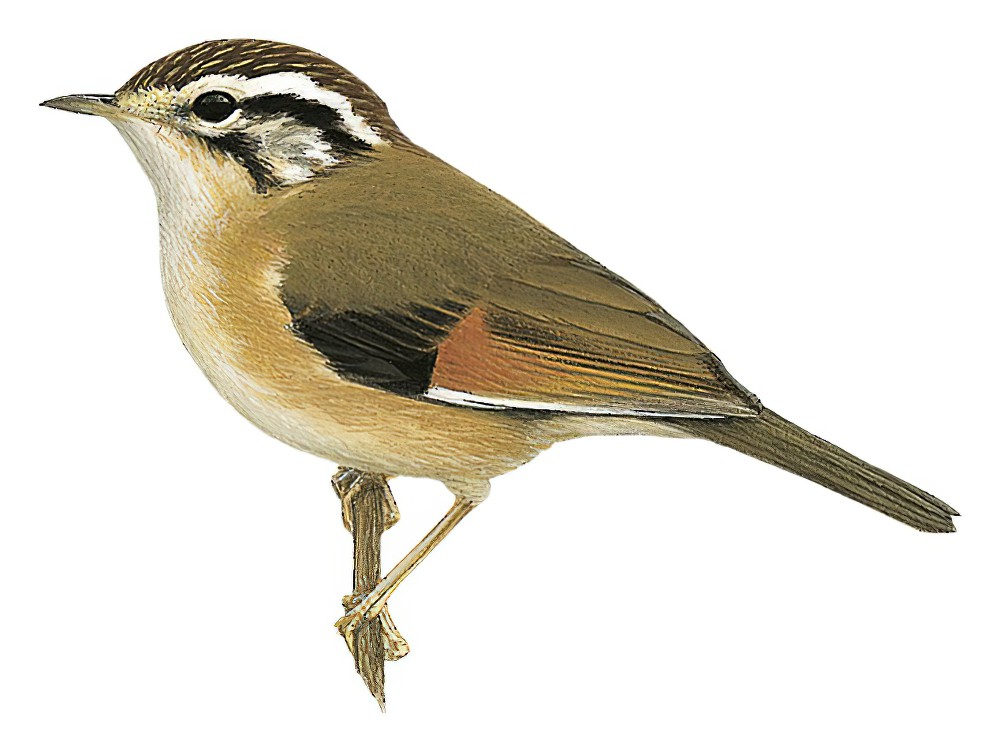Rufous-winged Fulvetta / Schoeniparus castaneceps

Rufous-winged Fulvetta
SCI Name:
Protonym: [Minla] Castaneceps Ind.Rev. 2 p.33
Taxonomy: Passeriformes / Pellorneidae / Schoeniparus
Taxonomy Code: ruwful1
Type Locality: Nepal.
Author: Hodgson
Publish Year: 1837
IUCN Status: Least Concern
DEFINITIONS
SCHOENIPARUS
(Pellorneidae; Ϯ Rusty-capped Fulvetta S. dubius) Gr. σχοινος skhoinos reed, rush; genus Parus Linnaeus, 1758, tit; "Proparus dubius, Hume. ... THIS last bird I described with some hesitation; it is a Leiotrichine form allied to Minla and Proparus, but distinct from all known species, I believe, of this group. ... In some particulars it closely resembles Mr. Mandelli's Minla rufogularis ... Could it be that my bird is the female, rufogularis the male? ... I am much puzzled about the location of this species. The wings are short and bowed, the fifth quill is the shortest, the sixth subequal, the bill is essentially Parian, but rather too much compressed and raised on the culmen. The tail is long and narrow and much rounded, perhaps cuneate is the proper term. The tarsus very stout, the feet moderate, the hind toe and claw long. It is structurally very similar to vinipectus, but alike in bill, tarsus and feet is more robust. The two clearly go together, but they are not in my opinion congeneric with chrysotis (vel chrysæus), Hodgson, and they are both more or less reed and grass-haunters. I would separate them as Schœniparus." (Hume 1874); "Schœniparus, g. n., type Proparus dubius, sp. n. (Hume, J. A. S. B. (n.s.) xiiii. pt. 2, p. 107), Tenasserim; A. O. Hume, Str. Feath. ii. pp. 447-449." (Sharpe & Murie 1876) (Mark Brown in litt.); "Schœniparus Anonymous = Hume, 1874, Stray Feathers, 2, p. 449. Type, by subsequent designation (Sharpe, 1883, Cat. Birds Brit. Mus., 7, p. 606), Minla rufogularis Mandelli." (Deignan in Peters 1964, X, 397).
Var. Schaeniparus.
Synon. Proparoides, Pseudominla, Semiparus, Sittiparus.
schoeniparus
L. schoenus rush, reed < Gr. σχοινος skhoinos rush, reed; Late L. parus tit.
castaneceps
L. castaneus chestnut-coloured < castanea chestnut < Gr. καστανον kastanon chestnut; -ceps -headed < caput, capitis head.
SUBSPECIES
Rufous-winged Fulvetta (castaneceps)
SCI Name: Schoeniparus castaneceps castaneceps
castaneceps
L. castaneus chestnut-coloured < castanea chestnut < Gr. καστανον kastanon chestnut; -ceps -headed < caput, capitis head.
Rufous-winged Fulvetta (exul)
SCI Name: Schoeniparus castaneceps exul
exul
L. exsul or exul exile < ex out of; solum country, land.
Rufous-winged Fulvetta (soror)
SCI Name: Schoeniparus castaneceps soror
soror / sorora
L. soror, sororis sister (i.e. closely related).
● "Ähnlich der X. f. flavigula Cab." (Neumann 1914) (subsp. Atimastillas flavigula).
● "Männchen dem vorgenannten Arten sehr ähnlich, im allgemeinen aber etwas kleiner, Schnabel wie bei B. puella, etwas schmaler als bei B. senegalensis und orientalis" (Reichenow 1903) (Batis).
● "Bisher habe ich unter dem Namen C. rufopileata Vögel von West- und Ostafrika zusammengefaßt. ... Als Typ für die Form soror ist ein Vogel vom Kilimandscharo. C. rufopileata scheint nur vom Niger bis zum Gabun verbreitet zu sein. Vögel von Loango gleichen der östlichen Form soror." (Reichenow 1916) (syn. Cisticola bulliens).
● "Der E. brunneiceps [= subsp. Erythropygia leucophrys] sehr ähnlich, aber kleiner" (Reichenow 1905) (syn. Erythropygia leucophrys zambesiana).
● "Von P. macrocerca (Lcht.) [= subsp. Euplectes macrourus] durch bedeutend geringere Grösse und etwas heller gelben Schulterfleck unterschieden" (Reichenow 1887) (syn. Euplectes macrourus).
● "This specimen may possibly prove to be an immature H. nipalensis, from which it differs in being slightly smaller and more slender in the tarsi" (Wardlaw Ramsay 1881) (Hydrornis).
● "Similar to pumila [= subsp. Lalage maculosa]" (Mayr & Ripley 1941) (subsp. Lalage maculosa).
● “typical Pachycephala, closely allied to P. melanura, but with the tail brown, bordered with olive-green” (P. Sclater 1874) (Pachycephala).
● "This subspecies is surprisingly similar to feminina [= subsp. Petroica pusilla], although the ranges of the two forms are widely separated by ambrynensis [= subsp. Petroica pusilla]" (Mayr 1934) (subsp. Petroica pusilla).
● "The name soror means sister, alluding to its close similarity with the other taxa in this [Seicercus (= Phylloscopus) burkii] complex" (Alström & Olsson 1999) (Phylloscopus).
● "Closely allied to M. castaneiceps, from which it differs in its much larger size" (Sharpe 1887) (subsp. Schoeniparus castaneceps).
● "The name of the subspecies is based on the close relationship of this indigobird with the other forms of the indigobird species" (Payne 1982) (syn. Vidua camerunensis).
● "Intermediär zwischen X. g. genibarbis Ill., aus Amazonien, und X. g. pelzelni [= syn. X. minutus] Hellm., aus S.-O.-Brasilien" (Hellmayr 1921) (syn. Xenops genibarbis).
Rufous-winged Fulvetta (stepanyani)
SCI Name: Schoeniparus castaneceps stepanyani
stepanyani
Leo Surenovich Stepanyan (1931-2002) Russian ornithologist, collector in southeast Asia (subsp. Schoeniparus castaneceps).
UPPERCASE: current genus
Uppercase first letter: generic synonym
● and ● See: generic homonyms
lowercase: species and subspecies
●: early names, variants, mispellings
‡: extinct
†: type species
Gr.: ancient Greek
L.: Latin
<: derived from
syn: synonym of
/: separates historical and modern geographic names
ex: based on
TL: type locality
OD: original diagnosis (genus) or original description (species)












